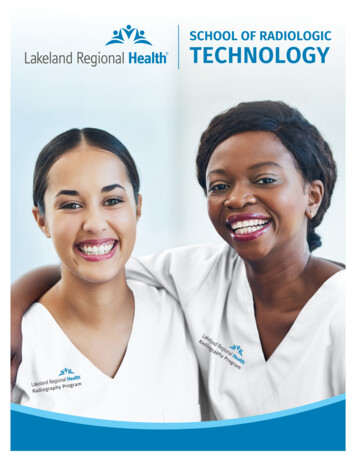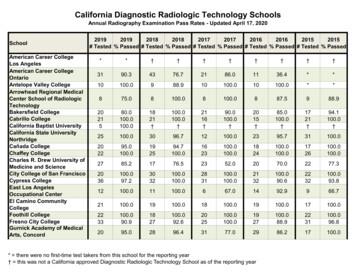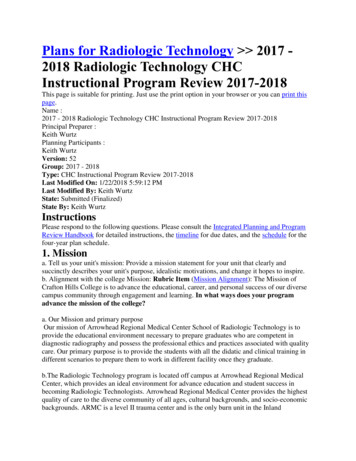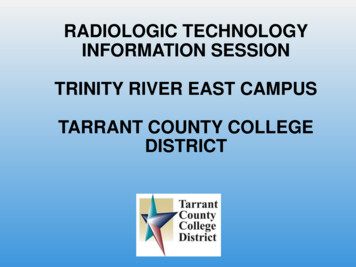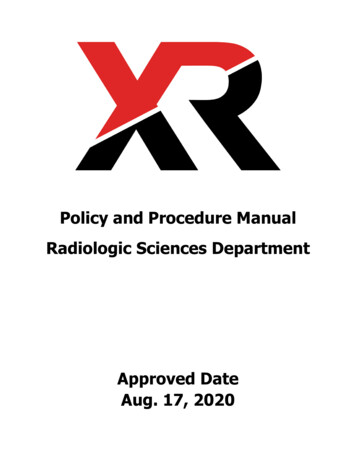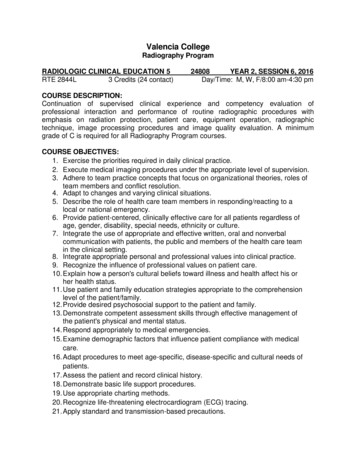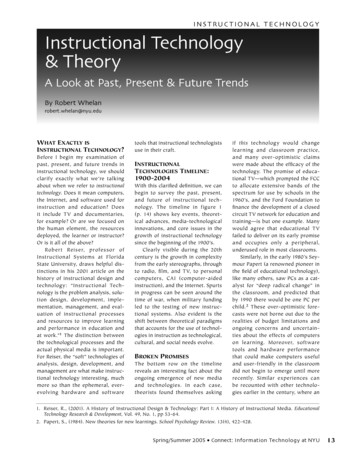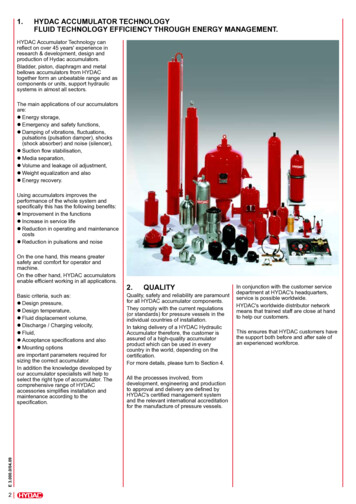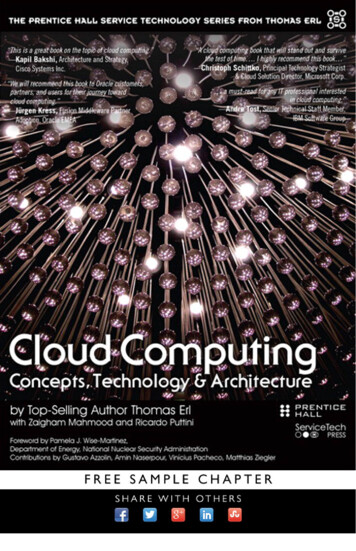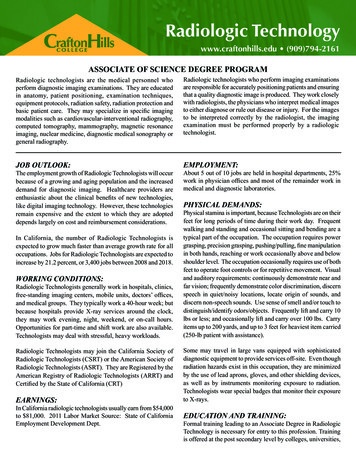
Transcription
Radiologic Technologywww.craftonhills.edu (909)794-2161ASSOCIATE OF SCIENCE DEGREE PROGRAMRadiologic technologists are the medical personnel whoperform diagnostic imaging examinations. They are educatedin anatomy, patient positioning, examination techniques,equipment protocols, radiation safety, radiation protection andbasic patient care. They may specialize in specific imagingmodalities such as cardiovascular-interventional radiography,computed tomography, mammography, magnetic resonanceimaging, nuclear medicine, diagnostic medical sonography orgeneral radiography.Radiologic technologists who perform imaging examinationsare responsible for accurately positioning patients and ensuringthat a quality diagnostic image is produced. They work closelywith radiologists, the physicians who interpret medical imagesto either diagnose or rule out disease or injury. For the imagesto be interpreted correctly by the radiologist, the imagingexamination must be performed properly by a radiologictechnologist.JOB OUTLOOK:EMPLOYMENT:The employment growth of Radiologic Technologists will occurbecause of a growing and aging population and the increaseddemand for diagnostic imaging. Healthcare providers areenthusiastic about the clinical benefits of new technologies,like digital imaging technology. However, these technologiesremain expensive and the extent to which they are adopteddepends largely on cost and reimbursement considerations.In California, the number of Radiologic Technologists isexpected to grow much faster than average growth rate for alloccupations. Jobs for Radiologic Technologists are expected toincrease by 21.2 percent, or 3,400 jobs between 2008 and 2018.WORKING CONDITIONS:Radiologic Technologists generally work in hospitals, clinics,free-standing imaging centers, mobile units, doctors’ offices,and medical groups. They typically work a 40-hour week; butbecause hospitals provide X-ray services around the clock,they may work evening, night, weekend, or on-call hours.Opportunities for part-time and shift work are also available.Technologists may deal with stressful, heavy workloads.Radiologic Technologists may join the California Society ofRadiologic Technologists (CSRT) or the American Society ofRadiologic Technologists (ASRT). They are Registered by theAmerican Registry of Radiologic Technologists (ARRT) andCertified by the State of California (CRT)EARNINGS:In California radiologic technologists usually earn from 54,000to 81,000. 2011 Labor Market Source: State of CaliforniaEmployment Development Dept.About 5 out of 10 jobs are held in hospital departments, 25%work in physician offices and most of the remainder work inmedical and diagnostic laboratories.PHYSICAL DEMANDS:Physical stamina is important, because Technologists are on theirfeet for long periods of time during their work day. Frequentwalking and standing and occasional sitting and bending are atypical part of the occupation. The occupation requires powergrasping, precision grasping, pushing/pulling, fine manipulationin both hands, reaching or work occasionally above and belowshoulder level. The occupation occasionally requires use of bothfeet to operate foot controls or for repetitive movement. Visualand auditory requirements: continuously demonstrate near andfar vision; frequently demonstrate color discrimination, discernspeech in quiet/noisy locations, locate origin of sounds, anddiscern non-speech sounds. Use sense of smell and/or touch todistinguish/identify odors/objects. Frequently lift and carry 10lbs or less; and occasionally lift and carry over 100 lbs. Carryitems up to 200 yards, and up to 3 feet for heaviest item carried(250-lb patient with assistance).Some may travel in large vans equipped with sophisticateddiagnostic equipment to provide services off-site. Even thoughradiation hazards exist in this occupation, they are minimizedby the use of lead aprons, gloves, and other shielding devices,as well as by instruments monitoring exposure to radiation.Technologists wear special badges that monitor their exposureto X-rays.EDUCATION AND TRAINING:Formal training leading to an Associate Degree in RadiologicTechnology is necessary for entry to this profession. Trainingis offered at the post secondary level by colleges, universities,
trade schools, vocational-technical institutes, and the ArmedForces. Formal training programs vary in length and in thecredential or degree awarded.CAREER LADDER:With experience and additional training, Technologists maybecome specialists who perform CT scanning, angiography, ormagnetic resonance imaging. They may also become radiationtherapists. Experienced Technologists also may be promoted tosupervisor, manager, and ultimately, department administratoror director. Some Technologists become instructors, clinicalcoordinators or directors in radiologic technology programs.RADIOL 209 Radiographic PathologyRADIOL 210 Radiographic Positioning IVRADIOL 211 Radiographic Anatomy/Physiology IVRADIOL 212 Special Procedures in RadiologyRADIOL 213 Radiographic Clinic IIIRADIOL 214 Radiographic Clinic IVTOTAL UNITS1.001.001.001.5014.2513.7582.75Labor Market and Occupation Information Source: U.S. Department ofLabor, Bureau of Labor Statistics and State of California EmploymentDevelopment Dept.Lower division requirements for students interested intransferring to a four-year institution in this field may differfrom associate degree requirements. Prospective transferstudents should complete the general education and lowerdivision requirements of the school to which they will betransferring. See a counselor for details. Information is alsoavailable at www.assist.org.ASSOCIATE OF SCIENCE DEGREERADIOLOGIC TECHNOLOGYRADIOLOGIC TECHNOLOGYCERTIFICATEThe Radiologic Technology program is sponsored by ArrowheadRegional Medical Center and accredited by the Joint ReviewCommittee on Education in Radiologic Technology (JRCERT).The program is affiliated with Crafton Hills College.NOTE: Prior to starting this degree the student must showproof of a clear criminal background check.REQUIRED COURSES:UNITSRADIOL 100 Introduction to Radiologic Technology 1.50RADIOL 103 Radiographic Positioning I1.00RADIOL 104 Radiologic Physics I1.50RADIOL 105 Radiographic Anatomy/Physiology I1.00RADIOL 106 Radiographic Positioning Lab I0.50RADIOL 107 Basic Radiologic Medical Techniques1.50RADIOL 108 Radiation Protection I1.50RADIOL 109 Radiologic Physics II1.50RADIOL 110 Radiographic Exposure I1.00RADIOL 111 Radiographic Film Critique I1.00RADIOL 112 Radiographic Positioning II1.00RADIOL 113 Radiographic Anatomy/Physiology II1.00RADIOL 114 Radiographic Positioning Lab II0.25RADIOL 115 Radiographic Clinic I11.50RADIOL 116 Radiographic Exposure II1.00RADIOL 117 Radiographic Clinic II15.00RADIOL 200 Radiation Protection II1.50RADIOL 202 Radiographic Film Critique II1.00RADIOL 203 Radiographic Positioning III1.00RADIOL 204 Radiographic Anatomy/Physiology III1.00RADIOL 205 Radiographic Exposure Lab0.50RADIOL 207 Radiographic Fluoroscopic Imaging1.50RADIOL 208 Radiography Registry Review and Testing 2.00NOTE: Prior to starting this program the student mustshow proof of a clear criminal background check.The objective of this certificate is to prepare students to becompetent practitioners in the field of radiography. Completionof the certificate will prepare the student to be eligible forthe state and national board examinations and for entry-levelemployment in radiography. The Radiologic Technologyprogram is sponsored by Arrowhead Regional Medical Centerand accredited by the Joint Review Committee on Education inRadiologic Technology (JRCERT). The program is affiliatedwith Crafton Hills College. Program applications, officialtranscripts, must be filed at ARMC School of RadiologicTechnology by April 1st. Application packets are availablefrom October through February of each year. The RadiologicTechnology program has special application and acceptancerequirements. Please visit www.arrowheadmedcenter.org undereducation for specific information. In 2015 all students willbe required to have an Associate Degree in order to receivea certificate of completion from the Radiologic Technologyprogram.AdmissionThe Admissions Committee selects students on the basis oftheir college grades, satisfactory completion of prerequisitecourses, and a personal interview. Interviews are granted tothirty applicants who have completed all prerequisite courseswith a minimum 2.5 GPA and have submitted a completeapplication package with the non-refundable fee. Theadmissions committee selects 8 students and four alternates.MINIMUM QUALIFICATIONS:To be considered for a personal interview the applicants must:Submit a completed application package and fee; provide a copyof their high school diploma or GED; successfully completethe college prerequisites listed below plus GE courses for anAA or AS degree:
PREREQUISITES:UNITS*AH 090 Survey of Radiologic Technology1.50*AH 101 Medical Terminology3.00*ANAT 101 Essentials of Human Anatomy and4.00Physiology*ENGL 101 Freshman Composition4.00*CIS 101 Introduction to Computer and Information3.00Technology*MATH 095 Intermediate Algebra4.00REQUIRED FIRST SEMESTER COURSESUNITSRADIOL 100 Introduction to Radiologic Technology 1.50RADIOL 103 Radiographic Positioning I1.00RADIOL 104 Radiologic Physics I1.50RADIOL 105 Radiographic Anatomy/Physiology I1.00RADIOL 106 Radiographic Positioning Lab I0.50RADIOL 107 Basic Radiologic Medical Techniques1.50RADIOL 110 Radiographic Exposure I1.00RADIOL 115 Radiographic Clinic I11.50REQUIRED SECOND SEMESTER COURSES UNITSRADIOL 108 Radiation Protection I1.50RADIOL 109 Radiologic Physics II1.50RADIOL 111 Radiographic Film Critique I1.00RADIOL 112 Radiographic Positioning II1.00RADIOL 113 Radiographic Anatomy/Physiology II1.00RADIOL 114 Radiographic Positioning Lab II0.25RADIOL 116 Radiographic Exposure II1.00RADIOL 117 Radiographic Clinic II15.00CONTINUING YOUR EDUCATIONTo fulfill the Associate Degree requirements you will need tocomplete all required general education (G.E.) units in additionto the Radiologic Technology core courses. It is importantthat you check with a counselor to insure that completion ofthe G.E. requirements is correct and in appropriate categories.ASSOCIATE DEGREE REQUIREMENTSCompletion of a minimum of 60 units, completion of theRadiologic Technology program core and non-core courses,and required general education are required for the AssociatesDegree. All courses must be completed with a “C” grade orhigher. Detailed Associate Degree Requirements can be foundin the current version of the Crafton Hills College Catalog, orsee a Counselor to assist you in course selection.ADMISSION TO CRAFTON HILLS COLLEGEAdmission to Crafton Hills College is open to those who meetany one of the following requirements: 1. Eighteen years of ageor older and can benefit from instruction offered by the collegeor 2. A high school graduate or 3. Have a G.E.D. (GeneralEducation Development) Certificate or 4. Have a CaliforniaHigh School Proficiency Certificate or 5. Out-of-state residentsand citizens of other countries here on student visas may alsoattend Crafton Hills College, subject to regulations that canbe obtained from the Admissions & Records Office. Thesestudents will be required to pay non-resident tuition fees.Current high school students may be admitted under specialcircumstances. Please see the current version of the CraftonHills College Catalog for eligibility requirements.REQUIRED THIRD SEMESTER COURSESUNITSRADIOL 200 Radiation Protection II1.50RADIOL 202 Radiographic Film Critique II1.00RADIOL 203 Radiographic Positioning III1.00RADIOL 204 Radiographic Anatomy/Physiology III1.00RADIOL 205 Radiographic Lab0.50RADIOL 213 Radiographic Clinic III14.25Every new student participates in the assessment process. Theassessment is designed to measure current skills and is usedto determine appropriate placement in English and Math. Foradditional information you may contact the Assessment Centerat (909) 389-3361 or e-mail testcenter@craftonhills.edu. Aftercompleting the assessment, it is recommended that studentsmeet with a counselor to discuss appropriate course work inaccordance with the student’s goals.REQUIRED FOURTH SEMESTER COURSES UNITSRADIOL 207 Radiographic Fluoroscopic Imaging1.50RADIOL 208 Radiography Registry Review & Testing 2.00RADIOL 209 Radiographic Pathology1.00RADIOL 210 Radiographic Positioning IV1.00RADIOL 211 Radiographic Anatomy/Physiology IV1.00RADIOL 212 Special Procedures in Radiology1.50RADIOL 214 Radiographic Clinic IV13.75TOTAL UNITS102.25Crafton Hills College is accredited by the AccreditingCommission for Community and Junior Colleges of theWestern Association of Schools and Colleges, 10 CommercialBoulevard, Suite 204, Novato, CA 94949, (415) 506-0234, aninstitutional accrediting body recognized by the Council forHigher Education Accreditation and the U.S. Department ofEducation.*Students may substitute equivalent or advanced levelcourses.
ADDITIONAL PROGRAM INFORMATIONARMC SCHOOL OF RADIOLOGICTECHNOLGYProgram Mission StatementThe mission of the Arrowhead Regional Medical CenterSchool of Radiologic Technology is to provide the educationalenvironment necessary to prepare graduates who are competentin diagnostic radiography and possess the professional ethicsand practices associated with quality patient care.Program Goals and Student Learning OutcomesFulfillment of the program’s mission is assessed by the degreethe program achieves the following Goals and Student LearningOutcomes, (SLO’s):GOAL #1 - The program will graduate students who areclinically competent.SLO: Students will demonstrate proper positioning skills,radiation protection practices, set appropriate technicalfactors, and provide for the comfort and care of the patients.GOAL #2 - Graduate students with problem solving and criticalthinking skills.SLO: Students will modify routine imaging parametersbased on patient’s conditions, demonstrate ability tocritique images for quality, and utilize these skills in theirfuture employment.GOAL #3 – Graduate students who demonstrate effectivecommunication skills.SLO: Students will demonstrate oral and writtencommunication skills.GOAL #4 - Graduate students who display professional valuesand good ethical behavior and strive for continued personal andprofessional growth.SLO: Students will display professional behavior in theclinical setting, choose to observe other modalities duringtheir elective rotation, and realize the value of professionaladvancement.AccreditationThis Program is accredited by the Joint Review Committee onEducation in Radiologic Technology (JRCERT). Any questionsconcerning the program accreditation status or programeffectiveness data may be directed to the JRCERT at:20 North Wacker Drive, Suite 2850Chicago, Illinois 60606-3182Tel: (312) 704-5300E-mail: mail@jrcert.orgWeb Site: http://www.jrcert.orgSponsorship / AffiliationThe County of San Bernardino sponsors this program atArrowhead Regional Medical Center: 400 North PepperAvenue, Colton, California 92324. The school is affiliatedwith Crafton Hills College: 1171 Sand Canyon Road, Yucaipa,CA 92399.Registry/CertificationArrowhead Regional Medical Center School of RadiologicTechnology offers a complete Hospital Based Certificateprogram in Radiologic Technology. All professional coursesare at Arrowhead Regional Medical Center. Students alsoenroll in Crafton Hills College and obtain an Associate ofScience Degree. It is mandatory for all Rad. Tech. studentsto enroll in the Radiography classes at Crafton Hills College.Students, who complete the Program curriculum, includingthe clinical education requirements, will receive a Certificateof Completion from ARMC School of Radiologic Technology.Each graduate will be eligible to take exams prepared bythe American Registry of Radiologic Technologists (ARRT)including Fluoroscopy, and Mammography (optional).Effective in 2015, graduates must have attained an Associatedegree minimum to be eligible for the initial ARRTcredentialing examination.Minimum QualificationsTo be considered for a personal interview, the applicantshall:1) submit a completed application package and 50.00 fee2) provide official College Transcripts3) complete the college courses listed below with minimum 2.5 GPA plus complete all General EducationCourses for AA or AS degree prior to the April 1stdeadline: English Composition: ENGL 101 or equivalentComputer Literacy: CI&S 101 or equivalentIntermediate Algebra Math 095General Anatomy and Physiology: 101 or equivalentMedical Terminology: AH 101 or equivalentSurvey of Radiologic Technology: AH 090 (offered atCrafton Hills College)Higher level classes, than the ones listed above, may beaccepted in lieu of these specific courses. However, we stronglysuggest that if any pre-requisite courses were completed at acollege other than Crafton Hills, you contact the counselingdepartment to insure equivalency. All courses must meetCrafton Hill’s requirement or they will not be accepted.Counseling office: (909) 389-3366.
Effective January 1, 2013 the prerequisites are expandedto include a minimum Associates degree or completion ofGeneral Education Courses leading to an Associates degree.This change is necessary because Radiologic Technologystudents graduating in the year 2015 must have a minimum ofan Associates degree in order to sit for the American Registryof Radiologic Technologists (ARRT) board examination.Note: The completion of a California Limited Permit programfor Radiologic Technician does not fulfill this programprerequisite course requirement.Technical Standards/Physical DemandsDuring the course of the program the student will be exposedto electricity, infectious materials and radiation. The studentwill be instructed on the use of specialized protective equipmentand clothing. The student must be prepared for the followingphysical demands of the clinical setting:Frequent walking and standing. Occasional sitting andbending. Requires power grasping, precision grasping, pushing/pulling, and fine manipulation in both hands. Reach or workoccasionally above and below shoulder level. Occasionallyrequires use of both feet to operate foot controls or for repetitivemovement. Visual and auditory requirements: continuouslydemonstrate near and far vision; frequently demonstrate colordiscrimination, discern speech in quiet/noisy locations, locateorigin of sounds, and discern non-speech sounds. Use senseof smell and/or touch to distinguish/identify odors/objects.Frequently lift and carry 10 lbs or less; and occasionally liftand carry over 100 lbs. Carry items up to 200 yards, and up to3 feet for heaviest item carried (250-lb patient with assistance).Admission to ProgramA student radiographer must be a mature, dependable personwho is “people-oriented” and genuinely interested in helpingthe sick and disabled. The Program selects students whosequalifications indicate the greatest potential for professionaland personal development. Eight students and four alternatesare selected each year by the admissions committee.Selection is based on pre-requisite course grades and personalinterview. Applications and transcripts will be presented to theadmissions committee who will select those whom they wishto interview. Each applicant will be notified of their status viae-mail by the 2nd week of April. Interviews are scheduledduring the 3rd and 4th week of April. Prior to the interview,each applicant will have 10 minutes to review the interviewquestions. Each applicant is asked the same questions andis evaluated by the committee. Applicants are provided anopportunity to ask questions.After the interviews have been completed, the new class isselected based on the following criteria: Response to interview questions – 80%Interview appearance 5%Re-applicant 5%Previous Alternate 10%Eight students are accepted and four alternates.All applicants are notified via e-mail attached letter of theirinterview results.Th
RADIOL 212 Special Procedures in Radiology 1.50 RADIOL 213 Radiographic Clinic III 14.25 RADIOL 214 Radiographic Clinic IV 13.75 TOTAL UNITS 82.75 Lower division requirements for students interested in transferring to a four-year institution in this field may differ
